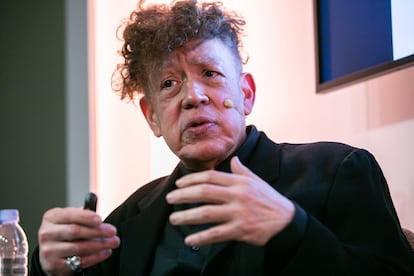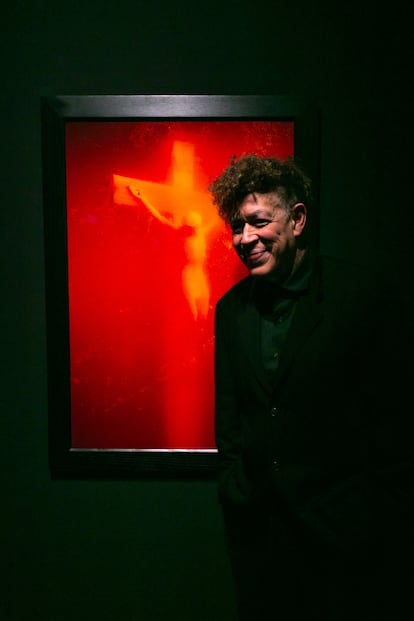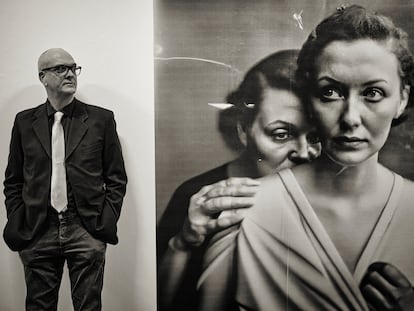Andrés Serrano, on his polemic work ‘Piss Christ’: ‘I’m still a soldier of God’
The Museu de l’Art Prohibit, founded by audiovisual magnate Tatxo Benet, has a copy of the controversial piece on display. We spoke with the U.S. photographer, who confessed that it hurts to be called anti-Christian


Few recent works of art have aroused such fierce hostility as Piss Christ, a 1987 photograph depicting Jesus within a container full of urine. Its creator, U.S. photograph Andrés Serrano (New York, 73 years old), served as scapegoat for two Republican senators, Al D’Amato and Jesse Helms, who used the work in their attacks on public art funding in the heat of the late 1980s culture wars — a moment that is in many ways echoed by today’s discourse. The work itself has been the object of violence on several occasions. Serrano was recently in Barcelona to participate in a public conversation at the Museu de l’Art Probit (Museum of Prohibited Art), which was founded by collector and audiovisual magnate Tatxo Benet and has a copy of Piss Christ in its permanent collection. The photographer remembers how, at the time of the piece’s debut, he did not understand the amount of hatred stirred up by what is now his most well-known work: “When I created it, I was an unknown, so I was shocked that politicians were so offended, that they came after me on a personal level. Even so, I wasn’t bothered by their reaction. I have always thought that my work is open to interpretation. If I have provoked someone into thinking and feeling, that alone makes me happy.”
Still, one thing that did hurt was being called anti-Christian. “I was brought up in Christianity, I am part of the church, and I feel connected to a long tradition of Christian artists working with the faith’s symbols,” he says. “At my confirmation, the nuns told me that I had become a soldier of God. Even though I stopped going to church for religious reasons, and now only go when I’m in Europe for artistic reasons, I’m still a soldier of Christ.”

Question. Of all the times Piss Christ has been attacked, one episode in Melbourne was particularly disturbing, in which the perpetrator was a teenager. How did it make you feel?
Answer. As far as I know, it was a 16-year-old boy who had seen his mother crying over the work, so he set out to destroy it. Before that took place, the archbishop of Melbourne, George Pell, tried to get Piss Christ banned from being shown, but the court said that it did not constitute blasphemy and that it could be exhibited. So, there were protests, and by the time I got there, there had been a lot of controversy and media attention. When the guy went to destroy it, I thought it was fine. I said to the museum director, “Hey, you should leave the work up like that until we get a new one.” But to my horror, that director canceled the exhibition two days later. So we all got angry: not just me, who then reported the decision to the press, but also the curator and everyone else who had worked on the exhibition. And I’ll tell you one thing about Archbishop George Pell: many years later, the Vatican called upon him to become treasurer or something, and they discovered that there were children who claimed he had abused them. [Indeed, Pell, who died in 2023, was sentenced to prison for child molestation, but the sentence was later overturned on the grounds that there was a “significant possibility” that he was not guilty.] This person who had attacked me was a blasphemer who had been doing something horrible to those children.
Q. Are you trying to say that those facts are connected?
A. I’m saying there are many Christians who are complete hypocrites. And I think that the Pope himself also knows it, because he has spoken about the retrograde Christians in America, who are truly retrograde, because instead of following the teachings of Christ about tolerance and accepting others, they do quite the opposite. And that is very anti-Christian.
Q. As you say, there are many possible interpretations of Piss Christ. What is yours?
A. When I create a photo, I know why I do it, but it’s not for a profound reason. Many times, I simply have an idea in my head and I carry it out, and later another explanation comes to me. I had been previously working with bodily fluids, and I decided to make some immersions in urine tanks, and then I added a crucifix, because even before that, I had been working with religious iconography. It united two of my lines of work: there was the piss and there was Christ, so I could only call it Piss Christ. And I didn’t think it was blasphemy or anything like that. A crucifix like this one has become so banal, it is even used as a fashion accessory and for many people, it doesn’t mean all that much. But when you spend so many hours crucified, everything comes out, piss and the shit, everything. So, if it offends you, you should think about what it represents, which is the horrible way in which Christ was murdered.

Q. In Spain, we just had another small scandal over the poster for the upcoming Holy Week in Seville, which shows what in reality is a very conventional Christ, with a beautiful body, which some people have perhaps seen as having homosexual connotations. At any rate, according to the New Testament, Christ was quite scandalous to society and the powers-that-be of his time, so doesn’t it follow that he would continue to be today, if only through the gaze of artists?
A. I had never thought of it like that, but you’re right. Christ himself was very controversial, so we’re only following in his footsteps with more controversy in his name. Christ and his symbols, like the crucifix, have created the most powerful religion on Earth. And that’s fantastic, that he has had such a prolonged impact, and on the lives of so many people, even to this day. There are many superheroes in the movies, but no one prays to them like they pray to Christ.
Q. But another one of your series, Residents of New York, shows people who are homeless, and no one is scandalized by that, which for a Catholic person should probably be much more offensive subject matter.
A. I’ve never tried to make offensive work, although some of my pieces have been intense. But in the case of homeless people, people don’t want to see them, they prefer to look the other way when faced with these injustices, and no one does anything about them. Another one of my series, History of Sex, was attacked by a handful of neo-Nazis, who filmed themselves doing it and made an extremely interesting movie that they put on YouTube, with heavy music and Nazi-type slogans like “degenerate art”. I always say that my work is quite basic, it doesn’t incorporate theory or art history, but rather has to do with simple things, like death, race, religion and sex.
Q. Do you think that censorship should not exist when it comes to art?
A. I think that you should be able to make whatever you want and not be arrested. And that if they do arrest you, that perhaps we need to change the laws.
Q. What should we do about work with messages of hate, racism or xenophobia, or that denigrates groups of humans like women or homosexuals?
A. In fact, there was another exhibition I did called Infamous, in which I included a postcard from 1907 that showed a man hanging from a tree. It’s not just that they lynched innocent Black people, it’s that people went to see it as if it were the circus or something like that, and that a person could even send a postcard with the image, and no one was offended. The past tends to repeat itself when you try to deny what took place. And I don’t want to avert my gaze. I want to see it, and talk about how it makes me feel.
Q. But you do that from a critical perspective. Imagine that another artist used the same postcard to say that we should go back to doing things like that. Should we allow something like that?
A. I can’t think of anyone brazen enough to do that. And I’m sure there are a lot of people who think that, but they would never express it openly. Today there are adverse reactions against everything, especially on social media. But look at America, where everything is so divided, everything is black and white. Half the people like Trump, and the other half hates them for it. There is no longer a unified front. I also say, the Civil War never ended. And you can tell, because when Trump came around, he said: “You guys don’t like those people and I don’t either, so let’s fuck them over!”
Q. You could say the same thing about Spain, our war was even more recent and was followed by 40 years of dictatorship.
A. And it was a horrible and brutal war, right? That’s the problem with war and religion, they destroy families, societies and nations. But what can you do when people are in complete opposition?
Q. Are you one of those people who think that you can no longer say anything because wokeness? Do you think we have less freedom of expression now than in 1987?
A. It could be. It’s true you can’t say anything. Very intelligent young people have been silenced just for feeling something. And that’s bad, and it goes beyond the woke. It has to do with intolerance for other people and ideas that are not their own.
Q. All art is political, even when that’s not the intention of its creator?
A. I always say that I am apolitical because I work with a group in London called a/political, but of course I have feelings. Although, in my work I prefer to be open, so that it can be interpreted in one way or another. I did a movie about the attack on the U.S. Capitol, Insurrection, which I made with video footage by the people who were there, who were recording themselves. It was like being there, from the excitement at the beginning to the melee at the end. And you see it, and if you’re a Trumper, you’ll like it, but you also will if you’re on the other side, because you’ll say: “Oh my God, look at that, there’s no police or military, if those people had been Black, they would have been shot immediately.” Of course, it could happen again, because if Trump comes back, he’ll have an even bigger army of loyalists, and maybe even the U.S. military forces behind him. So who knows what will happen.
Q. Are you worried about the political situation in the United States?
A. I’m not too worried, because all civilizations fall, so whatever happens, happens. That’s the curse of human beings, that they have to destroy each other in some moment.
Q. I have read that the only person who has given you directions on how to photograph them was Yoko Ono. What happened there?
A. Yes! I like to photograph people from below, but she told me: “No no, Andrés, bring the camera up!” So I said: “OK, Yoko.” Sweet Yoko!
Sign up for our weekly newsletter to get more English-language news coverage from EL PAÍS USA Edition








































